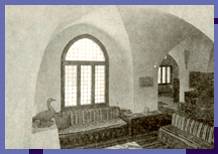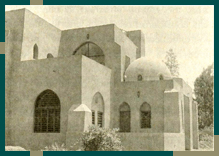|
RAMSES WISSA WASSEF
 Mounir
Nosshi House - Harrania
Mounir
Nosshi House - Harrania |
Ramses Wissa Wassef was born into a prominent Coptic Egyptian
family where art had always held a special significance. His
father, a lawyer and politician, was an influential member
of the nationalist Wafd party who played an important role
in the struggle for Egypt's independence. A frequent visitor
to the home was the well-known sculptor Mahmoud Moukhtar whom
Ramses greatly admired as a child. Already by the age of five
he had shown uncommon artistic talent and had earned himself
the nickname "the artist." He completed his primary and secondary
studies with honors at the French College in Cairo and later
went on to study in France.
Although his initial ambition was to become a sculptor, he
studied architecture at the Ecole des Beaux Arts, in Paris.
There he followed his prescribed course of studies without
neglecting drawing and sculpture. It was at this time that
his first thoughts concerning the teaching of art and the
role of the teacher emerged. Ramses had been very disappointed
by the academic teaching he had received and he viewed this
education more as a detriment rather than an aid to fulfilling
creative expression. In 1935 he received his diploma after
submitting a final project entitled, "The Potter's house in
Old Cairo". Even then his interest in Egyptian crafts was
evident.
Upon returning to Egypt, he was appointed professor of art,
and history of architecture and then head of department at
the Ecole des Beaux Arts in Cairo. Until 1969, he had been
discontented by the state of architecture in Egypt. At that
time, he wrote:
"What I could not explain was why our
own civilization should produce such coldness and ugliness
to replace the wealth of indigenous architecture. I used to
like walking through the old parts of Cairo, but even there
hideous fungus-like "modern" buildings are going up, insults
to human sensibility. And it is even sadder when it happens
in the open countryside. I also realized from my travels that
there were degrees in the poverty of modern architecture;
but towns and cities everywhere are increasingly coming to
look like machines"
For Ramses, the "modern architectural revolution" which had
hit Cairo was producing a multiplicity of buildings constructed
without any sense of aesthetics but rather for their fast
rentability. From this point on, Ramses was firmly resolved
to never sacrifice his artistic vision for current rends in
construction. He sought rather to devise a synthesis that
gave his country's architecture a national character one that
was influenced by the way of life of its people, its climate,
its traditions and the country's vast cultural inheritance.
It was in the course of one of these trips to Upper Egypt.
In the company of his students, that Ramses discovered the
beauty of the Nubian villages.
|

|
There the houses are composed of mudbrick vaults and domes,
a style that perpetual, is a tradition going back to the early
Egyptian dynasties. This discovery revealed to Ramses the
connection he had been seeking with the past. It was not his
intention however to return to this method completely, but
rather to bring it back to life by reinterpretation. Here,
Ramses describes his discovery in Aswan.
"I had just visited Aswan, where I
had been struck by the Beauty of the Nubian houses in the
villages of the area. I learnt that it was still possible
to find bricklayers who could make vaulted roofs for houses.
I felt a strange excitement when I thought that these same
methods had existed since the first dynasties of the Pharaohs.
They had survived throughout Egyptian, Coptic and Islamic
history, and were still used in popular architecture. I decided
to make use of some of these bricklayers from Aswan and turn
their experience to account in building vaults for my school."
In order to build with vaults and domes, Ramses had originally
brought workers from upper Egypt to construct the first rooms
of the center. Realizing the impracticality of bringing these
builders, he had hoped that the children themselves would
embrace this form of architecture and use it for their own.
construction. In this way he would plant a seed for future
generations.
Unfortunately this did not happen on a large scale. For these
children, the stigma attached to clay, which was considered
unhealthy and for the poor and uneducated, prevented them
from ever adopting it. Ramses did however teach some of the
young male students at the center to prepare mud bricks and
build walls in the traditional manner.
Under Ramses' guidance, their first project was to build
a small chicken coop in adobe using Nubian features (vaults
and domes). It was to be a miniature of the weavers' future
workshop. At the center, the buildings were distinctive for
their simple beauty and provided the weavers with just the
right atmosphere in which to work - one that protected them
from the heat and shaded them from the glare of the sun. The
qualities of this project received formal recognition when
in 1983 the Aga Khan Architectural Award was given.
 Ceres
Wissa Wassef's House - Harrania
Ceres
Wissa Wassef's House - Harrania |
Wissa Wassef's architectural achievements are numerous and
varied. The best known are his Art Center at Harrania, Mahmoud
Mouktar's Sculpture Museum in Cairo, two church-cathedrals
in Zamalek and Heliopolis, his own house in Agouza, Habib
Gogry's Sculpture Musuem and the homes of Mounir Nosshi and
Ceres Wissa Wassef, also at the centre in Harrania. Many varieties
of craftsmanship grace his buildings in harmonious blend -
his stained glass window designs winning particular acknowledgment.
For this he was awarded the National Prize for the arts in
1961 and 1984.
Indeed Wissa Wassef was a remarkable man, for his talents
are alive not only in the students who perpetuate the crafts,
but also in his structures which will remain monuments of
his diverse abilities for years to come.
|
|